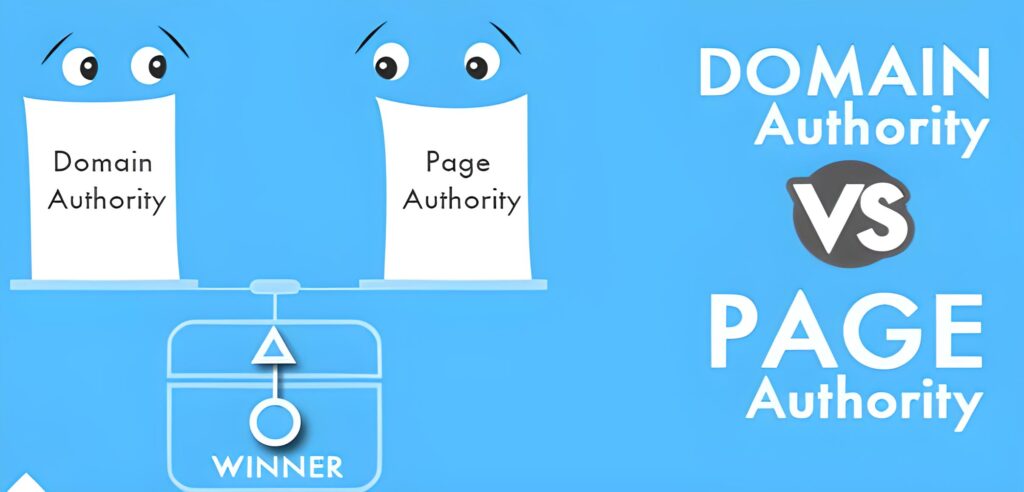What Is DA And PA In SEO?
SEO encompasses a multitude of crucial components, incorporating both official and unofficial metrics. Among these metrics, we encounter Domain Authority (DA) and Page Authority (PA), often abbreviated as DA and PA.
Experts emphasize that Google doesn’t formally endorse DA and PA as metrics, yet they don’t discredit their significance either. Consequently, these two factors remain highly relevant in the realm of SEO.
However, it’s imperative to understand the essence of DA and PA, their significance within SEO, and the distinctions between them. This article aims to address these inquiries comprehensively, so let’s commence our exploration.
Definition of DA
Domain Authority, abbreviated as DA, serves as a vital metric employed by SEO professionals to gauge a website’s relevance within its specific category or industry. This ranking score was conceived by Moz and has gained increasing importance in recent years.
The concept of a domain authority-like measurement for websites has been in existence since 1999, though its significance has grown significantly more recently. The scale for measuring domain authority spans from 1 to 100, incorporating various factors including:
- The quantity of inbound and outbound links.
- The presence of dead or obsolete pages.
- The caliber and size of utilized backlinks.
- The count of distinct root domains linked to a website.
- The quality and loading speed of the website’s pages.
These factors collectively establish the fundamental characteristics of a domain and its relevance within its specific niche or industry. Here are some reference scores to assist in gauging a website’s DA:
- Scores below 10 are considered inadequate.
- A range of 20-40 is deemed below average.
- A score between 40-50 is considered average.
- Ratings falling within 50-60 are regarded as indicative of a good DA.
- Any score surpassing 60 is considered an excellent DA rating.
Hence, these guidelines should facilitate the assessment of whether a website possesses a favorable DA score or not.
Definition of PA
In contrast to Domain Authority, Page Authority, often referred to as PA, assesses the quality and credibility of individual web pages. It serves as a valuable tool for predicting a webpage’s likelihood of ranking on search engine result pages.
Page Authority, like Domain Authority, employs a scoring system ranging from 1 to 100. A higher PA score indicates greater prospects for a page to secure a position in Google’s SERP. According to MOZ, Page Authority is determined by several key factors, including:
- The quality and trustworthiness of links featured on the page.
- The relevance and contribution of backlinks to the page’s content.
- The currency of the page’s content.
Additionally, the page’s loading speed also exerts a significant influence on achieving higher PA scores. It’s important to note that Page Authority, much like Domain Authority, isn’t an officially recognized metric by Google. Nevertheless, Page Authority ranking should be utilized to assess the quality of individual webpages within a website.
Importance of DA and PA in SEO
Certainly, Domain Authority (DA) and Page Authority (PA) play pivotal roles in achieving higher rankings on Google. Here’s how they relate to the factors you mentioned:
- Ranking Higher on Google: DA and PA serve as indicators of a website’s and specific page’s potential to rank higher in Google’s search results. By improving these metrics, you can enhance your website’s overall search visibility.
- Enhancing Crawl Demand: A higher DA and PA can attract more search engine crawlers to your website. By optimizing your content and backlinks to boost these metrics, you increase the likelihood of search engines regularly crawling and indexing your site.
- Removing Dead/Zombie Pages: A careful analysis of DA and PA can help you identify and address dead or obsolete pages on your website. Removing or updating such pages can improve your site’s overall quality and relevance.
- Enhancing Backlink Quality: DA and PA take into account the quality and relevance of backlinks. Focusing on high-quality, relevant backlinks can positively impact both metrics, which, in turn, can lead to improved search engine rankings.
- Improving Content Quality: High-quality content is a key factor in improving DA and PA. By creating valuable, informative, and engaging content, you can attract more high-quality backlinks, boosting your authority metrics and, consequently, your Google rankings.
In summary, DA and PA are essential factors in Google ranking because they provide insights into the overall health and authority of your website and its individual pages. Improving these metrics involves a holistic approach that encompasses content quality, backlinks, and website maintenance, all contributing to a better position in Google’s search results.

Key Differences between PA and DA
Indeed, the distinction between Page Authority (PA) and Domain Authority (DA) is straightforward: PA evaluates the merits of specific webpages, while DA assesses the website as a whole, encompassing its overall quality. Interestingly, despite their differing scopes, the methodologies used to determine both PA and DA share many similarities.
For instance, both PA and DA rely on common key factors, including:
- Link Analysis: This entails evaluating the quality of links, discerning between spammy and high-quality links, and considering links from highly-ranked websites. Such link-related assessments play a significant role in determining both PA and DA.
- Identification of Dead Links and Zombie Pages: The presence or absence of dead links or zombie pages is a shared consideration. These issues can negatively impact the authority of both individual pages and the overall website.
- Content Quality: Assessing the quality of content, whether on a webpage or across the entire site, is a fundamental factor in both PA and DA evaluations.
- Crawl Demand Potential: The assessment of a website’s or page’s crawl demand potential, or how frequently search engines crawl the content, is a common component in the determination of both PA and DA.
In essence, while PA measures the ranking potential of specific pages in search engine results, and DA gauges a website’s likelihood of ranking, they both rely on similar criteria to make these assessments. Understanding these metrics and the factors that influence them can aid website owners and SEO practitioners in optimizing their online presence for better search engine rankings.
How To Check DA And PA?
Assessing Domain Authority (DA) and Page Authority (PA) is a relatively straightforward process, and there are various tools available for this purpose. While Moz provides its own tools for checking DA and PA scores, other reputable SEO platforms like Moz, SEMrush, Majestic, and Ahrefs also offer similar capabilities. However, it’s important to note that many of these tools often come with subscription fees or usage costs.
You mentioned Da Pa Checker as an alternative. DA and PA checker. Depending on your specific needs and budget, this can be a cost-effective alternative to the premium tools mentioned above.
When selecting a tool to check DA and PA, consider factors such as accuracy, ease of use, the frequency of checks you require, and the features offered by each tool. Ultimately, the choice of tool should align with your SEO objectives and budget constraints.
4 Tips To Improve DA/PA
- Acquire High-Quality Backlinks: High-quality backlinks are a cornerstone of SEO. Seek out authoritative and relevant websites in your niche to build natural, high-quality backlinks. As these backlinks accumulate, both your DA and PA scores are likely to increase.
- Create Link-Worthy Content: Quality content is fundamental to SEO success. Develop content that is informative, engaging, and valuable to your target audience. When your content is considered link-worthy, other websites are more likely to link to it, thereby boosting your authority metrics.
- Remove Bad or Broken Links: Bad or broken links not only harm user experience but also negatively impact your SEO efforts. Regularly audit your website to identify and eliminate these links. This action not only enhances specific page quality but also contributes to improved DA and PA ratings.
- Improve Internal Linking: Internal linking is often overlooked but can significantly benefit your website’s crawlability and authority. Establish a logical structure of internal links to connect relevant pages on your site. This not only aids search engine crawlers in indexing your content but also positively influences your DA and PA scores.
By implementing these strategies and maintaining a consistent focus on the quality of your website’s content and backlink profile, you can enhance both your Domain Authority and Page Authority, ultimately improving your website’s overall SEO performance.
Conclusion
Indeed, while Domain Authority (DA) and Page Authority (PA) may not be officially endorsed by Google, their importance in SEO cannot be overlooked. These metrics serve as valuable indicators for website owners and SEO practitioners to gauge and enhance the quality and performance of their websites. By focusing on improving DA and PA through high-quality content, strong backlinks, and sound internal linking practices, you can positively influence your website’s search engine rankings and overall online presence. These metrics are, therefore, key tools in the pursuit of effective SEO and website optimization







